Facebook is hands down the biggest social media site in the world!
- It has 2.89 billion monthly active users,
- And 66% of them use the platform daily.
But why does that matter to you? Well, in today’s crowded market, advertising for your e-commerce without social media is pretty much a non-starter. You need social media traction. Which means you need Facebook.
The challenges created by Facebook’s algorithm changes
However, the good old days, when simply making a post enough to get attention, are over. That’s because Facebook has been making some important changes to its algorithm in response to the platform’s growing user base and gigantic amounts of content.
The most important change to the Facebook algorithm that e-commerc marketers need to understand is this:
Facebook now values posts from regular user higher than those made by Facebook pages (like your e-commerce store).
This means that many businesses, regardless of size, have been finding their posts sidelined and easily drowned out by content shared between family members and friends – what Facebook calls “meaningful interactions”.
So, if you want to keep your e-commerce business visible and impactful on Facebook, it’s time to learn how to leverage the Facebook algorithm to your advantage. And we’re here to help with a handful of dependable strategies you can use to crack the Facebook algorithm.
But first things first, let’s find out how it actually works.
Here’s how the Facebook algorithm works in 2021

At its most basic, the Facebook algorithm is a set of proprietary instructions rendered in code. OK, let’s translate that tech-speak into something understandable. Basically, Facebook’s algorithm enables the platform to rank user-generated content and serve it up to a user’s Facebook news feed based on what they’re likely to be interested in.
So, you open up the Facebook app and see posts that you should be interested in. But how does the Facebook algorithm show you what you’ll be interested in?
- Well, first it analyses what types of posts they’ve engaged with in the past.
- Once that’s been determined, Facebook will promote the content it “thinks” you might like to the top of your news feed.
- This content is shown in a non-chronological order, so the order in which you see posts don’t necessarily reflect when they were posted or shared. In other words, algorithmic “relevance” always takes priority over publication date.
Facebook’s goal, of course, is to keep those precious eyeballs on its platform for as long as possible. It wants to keep you scrolling through reams and reams of enticing content.
Cool. But what exactly determines how a post is ranked? The ranking factors can be roughly divided into four categories: inventory, signals, predictions, and relevance score.
Facebook ranking factor 1: Inventory
This is an umbrella category that encompasses all content on the platform – posts by friends and family, Facebook groups, videos, Facebook pages, and everything in between.
Facebook ranking factor 2: Signals
There are 2 types of ranking signals that Facebook uses: passive and active.
Passive ranking signals include metrics like view time, publication date, and story type.
Active ranking signals, on the other hand, are mostly related to engagement. These include likes, comments, shares, and many other metrics. (This is where your business can make its mark and crack the algorithm - more on that soon).
Rather than simply list all of the active signals that feed into the Facebook algorithm, we’ll be addressing some of the most important ones in the Strategies for Beating the Facebook Algorithm section below.
Facebook ranking factor 3: Predictions
You can probably guess what this one means – yup, it’s the Facebook algorithm buzzing in the background and collecting data about your activities on the platform. It uses this data to populate your Facebook news feed with content that you may find relevant.
A clear example of the prediction engine in action is Facebook ads that seem to match your previous searches. The same logic also applies to all other content you see in your news feed.
Facebook ranking factor 4: Relevance score
The Facebook algorithm ranks every piece of content on the platform and then uses that score to curate a selection of posts and other content based on each user’s individual preferences (or at least the closest approximation of them).
Facebook algorithm updates for 2021
So that’s how the Facebook algorithm works in general. But what about the specific changes that Facebook has made in 2021? Let’s take a look.
Feed Filter Bar
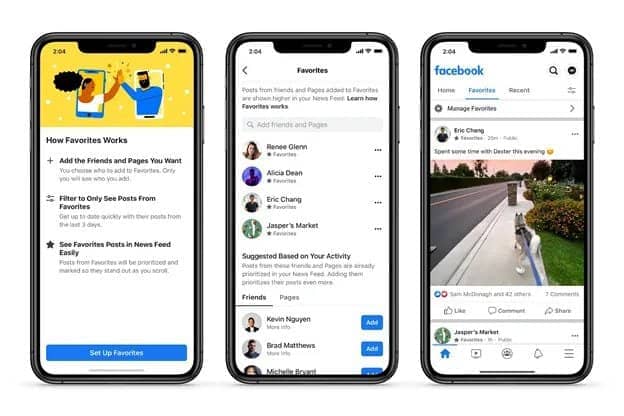
Rolled out on 31 March 2021, the Feed Filter Bar gives users more control over what shows up in their news feeds. In addition to being able to choose who can leave comments under your posts, you also have three basic options when it comes to the content in your news feed:
- Algorithmic display – this is the default option, so nothing will change if you select it.
- Chronological display – posts will be ordered by date and time of publication.
- Favorites display – you can manually select up to 30 friends and/or Facebook pages whose posts will be pushed to the top of your news feed.
Original source primacy
Responding to calls from institutions and citizens to curb the spread of fake news, Mark Zuckerberg and his team adjusted the Facebook algorithm to boost original reporting. The news stories you see will still be mostly from the media outlets that you or your friends follow, except that more original stories will appear first.
Later updates have also given more weight to reports from sources that provide information about their editorial staff, as well as those containing exclusive source materials, significant analysis, original visuals, and new interviews.
New Access your Information tool
First launched back in 2018, the Access your Information tool has been given a new coat of paint to make sure that your information on Facebook is useful, easy to understand, and always handy.
Based on Facebook’s own research into what people have been clicking on, the first update was an expanded list of data categories. Instead of just two, you now have eight categories that further break down into multiple subcategories:
- Your activity across Facebook
- Friends and followers
- Preferences
- Personal information
- Logged information
- Ads information
- Apps and websites off of Facebook
- Security and login Information
And the second update is a search functionality that provides suggestions when you start typing – just like when you search for something using Google’s search engine.
Strategies for beating the Facebook algorithm
OK, so you’re all clued up on the Facebook algorithm and how it’s been adjusted. Now it’s time for the million dollar question - how do you beat?
We’re going to take you through 9 strategies for cracking the Facebook algorithm. The main purpose here is to increase engagement so you can reach your audience organically. This is done by securing the three key things:
- Likes,
- Comments,
- and shares.
So, let’s get into the key strategies that will maximize your effectiveness on Facebook.
Facebook algorithm strategy #1: post valuable content

If your content isn’t good enough, adding in all the other strategies will not do very much. So let’s start with the most fundamental point of all - the content that you actually post on Facebook.
Take a moment to look at your Facebook news feed – what do you see? It sure ain’t some random stuff that bears no relation to anything you’ve liked or shared in the past, is it?
A mistake that new e-commerce businesses often make is to jump straight into promotional campaigns before they’ve secured a steady following. Instead, you should first focus on building your audience. To do that, you first have to commit to posting content that your target audience actually cares about. In other words, their needs and desires should come before you own. Otherwise you’ll probably end up with an account that’s only followed by your friends and family.
So, sit down and answer these questions:
- What is your target audience, exactly?
- Why do they go online?
- What are they looking for?
- What types of content are the most likely to spark conversations and expose your brand to those you’re trying to reach?
Once you have a great topic to post about, make sure you use eye-catching images and videos to increase your chances of people stopping mid-scroll to check out what you’ve got to say.
Once you have your track record of making attention-worthy content established, you can then start promoting your products more directly. You can also start using other strategies (such as the ones below) for muscling your way to the top of people’s news feeds.
Facebook algorithm strategy #2: use mostly native content
Building on the strategy above, focus on creating posts and content intended exclusively for Facebook.
Given the platform’s strategy of keeping users on it for as long as possible, it wouldn’t make very much sense for Facebook to promote content which takes them outside of its ecosystem.
So, long story short, research on Facebook’s algorithm has demonstrated that content made specifically for Facebook does better. So if, for example, you want to share a video, make sure to upload it directly to the platform, rather than share a link to YouTube or another site.
If you want to share an article, try to condense its key points into several paragraphs and post them to Facebook as a single post or a series of posts. This will perform better than sharing a link to an article which is published elsewhere.
This doesn’t mean that you should never provide links to websites outside Facebook. Just try to have most of your content contained within the platform’s boundaries and you’ll get some extra brownie points from the Facebook algorithm.
Facebook algorithm strategy #3: boost your posts
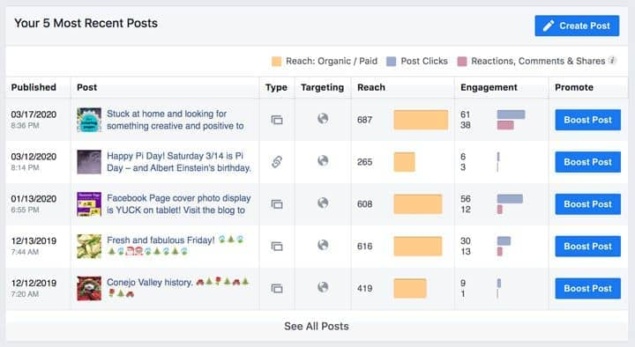
As any social media advertising pro will tell you, successfully competing for the same few seconds of attention on a platform with nearly 3 billion users is virtually impossible. So sometimes you’re going to need to give your posts a little boost.
Here’s why. Even if you have a decent following, your content is likely to be drowned out by posts of users’ family and friends, as per Facebook’s recent policy of promoting “meaningful interactions”. The situation is further complicated if you’re starting from scratch, with no followers and a low engagement rate.
So what do you do?
The answer is actually quite simple – boost the posts that you want to expose to as many people as possible. On this count, there are two pieces of good news.
Firstly, boosting your posts is relatively inexpensive and quite effective. Spending just $5 on a post can significantly increase your engagement rate and gain some new followers.
And secondly, increasing engagement also extends your organic reach – a boosted post will reach more people than otherwise. And if they like it, your content will be promoted by the Facebook algorithm and show up more frequently in their news feeds.
This means that you won’t necessarily have to continue spending money on boosted posts indefinitely – you can think of this strategy as bootstrapping or jump-starting a post, rather than permanently promoting it.
Facebook algorithm strategy #4: spark a conversation
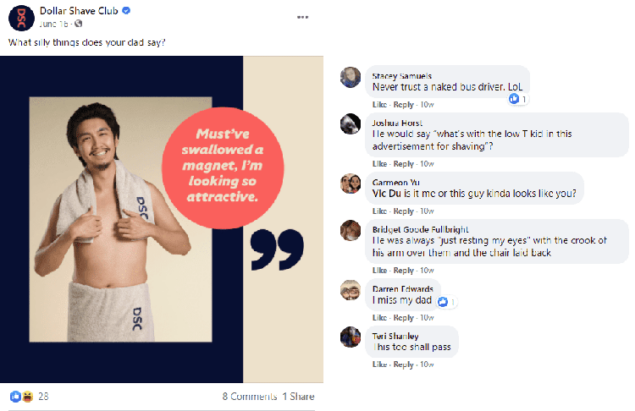
Whatever you happen to be posting about, you should always try to get people talking.
Get them engaging through likes, shares, or comments because this will ensure that your posts show up in your audience’s news feeds in the future.
A good way to do this is by asking questions – the simpler, the better. Ultimately, what matters is not so much the replies themselves, as the simple fact that people are replying.
To make things as easy as possible, consider polls, quizzes, and similar post formats that provide options, rather than open-ended questions (e.g., “Which dress do you prefer – the blue or the green one?” is better than “What do you think of this dress?”).
Strategy #5: prioritize reactions over likes
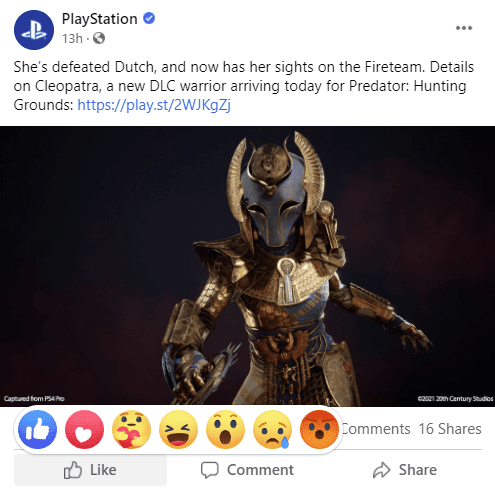
First of all, just to be clear, we’re talking here about likes for posts rather than likes for your business’ page (Getting likes for your page is really worth doing, and this guide to getting more Facebook likes will show you how).
No, we’re talking about post likes, and the difference between these and reactions. When they were first introduced in 2016, Facebook reactions had the same “weight” as regular likes. Now, however, they are worth quite a bit more.
Facebook offers a total of six reactions in addition to regular likes: Love, Haha, Wow, Sad, Angry, and Care (the last was introduced in 2020 to help people show virtual support to each other during the pandemic).
So if reactions are worth more, how do you encourage people to hit the reaction buttons instead of the gold ol’ thumbs up? The most straightforward answer to that is, of course, by making them feel a particular emotion. Try sharing a sensitive story or cracking a joke.
In addition, you can go about it more directly, namely by giving your followers a little nudge in the right direction. The most obvious – and perhaps the riskiest – way to accomplish that is by dropping the name of the emotion you’re looking for in the post.
Another way is to do polls or quizzes that ask users to reply by using one of the reaction buttons instead of leaving a comment.
If you decide to go with either of the two strategies, make sure not to violate Facebook’s guidelines in this regard. Here they are:
- The reactions you’re asking for should always match their intent. To put it another way, Facebook doesn’t want you to associate its reaction buttons with any specific piece of content (say, a picture), thereby depriving users of their freedom of expression. So don’t go about slapping Wows on your products and Angries on your competitors’ products, and asking followers which one they prefer.
- No looping or static videos in reaction polls. Despite the popularity of video-based content, Facebook has admonished its users against using graphics-only video polls, which it considers to be low-quality content.
Facebook algorithm strategy #6: avoid engagement bait
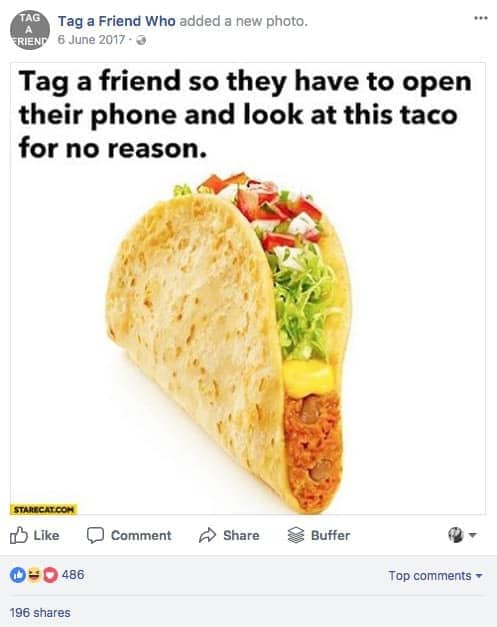
Encouraging people to engage with your posts can sometimes go a little too far. Just a few years ago Facebook was flooded with annoying posts that directly asked users to comment, like, share – you name it.
For a while, people didn’t seem to mind it very much. But once the volume of these posts got too high, Facebook went ahead and changed the algorithm to discreetly penalize posts which explicitly ask their followers to engage (“Make sure to SMASH that ‘Like’ button!”).
So, as tempting as it may be to solicit engagement by just asking for it, you’d likely be shooting yourself in the foot. The more you nag, the less people will engage, and the less your content will be promoted by the Facebook algorithm.
Facebook algorithm strategy #7: talk to your audience directly
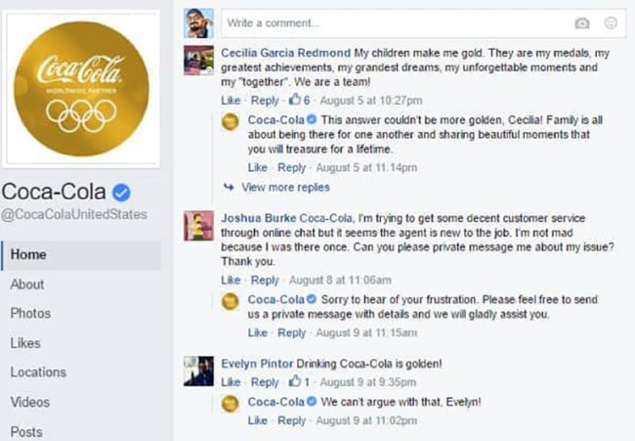
Here’s a little nugget of truth that people often forget – engagement goes both ways. Commenting, replying to comments and mentions, direct messaging – all of this counts as engagement, and therefore contributes to your subsequent organic reach.
Let’s say you made a post and someone left a favorable comment. To keep the ball rolling and boost engagement, you can reply with something witty, sincere, or insightful. The next user who stops by is now more likely to comment as well because you’ve demonstrated that you’re willing to have an actual conversation.
So, if you want to really maximize the benefits of your social media presence, don’t just count the comments and other tokens of engagement, and stay passive – engage back!
And this is useful not only because it improves your algorithmic ranking by jacking up your engagement rate. It also gives you an opportunity to build rapport with your current audience (and increase their loyalty), and even attract new followers.
So, don’t leave people hangin’ - reply, reply, reply!
Facebook algorithm strategy #8: rise above the algorithm with Facebook Stories

Here’s a cool thing about Facebook Stories – they’re not considered to be part of the news feed. As a result, they aren’t governed by the Facebook algorithm.
A survey report by Facebook stated that more than 1 in 2 people who use Facebook Stories claim they have “strengthened their relationships with brands, and many indicated that stories propel them through the purchase process”.
Here are the stats in detail:
- 69% said that Stories by brands help them discover new products and services,
- 62% said they have become more interested in a brand of product after seeing it in Stories,
- and 31% said they are more likely to connect with their favourite brands through Stories in the future.
Okay, so Facebook Stories have the super-power of skipping the algorithm and encouraging people to connect with brands and purchase their products and services. But what types of Stories are the best in this regard?
According to another study by Facebook, users are mostly interested in:
- Stories that are easy to understand (52%),
- Stories that showcase new products (50%),
- and Stories that feature tips and advice.
Facebook algorithm strategy #9: post when your audience is online
This one seems quite obvious, and chances are you’ve already heard it multiple times. But it bears repeating.
Coupled with posting on a regular basis, this strategy can give you a real boost in terms of engagement. When it comes to the best time for posting on Facebook, research is mixed, with different studies finding different times to be optimal.
For this reason, the best data is your own. Luckily, Facebook provides a wealth of data to Page owners. This makes it relatively easy to find the sweet spot. Here are the steps to follow:
- Head on over to the “Insights” dashboard at the top of the page,
- Click “Posts” in the left-hand column menu,
- This will show you when your followers are most active on the platform.
Facebook algorithm takeaways
So that’s it, your complete guide to beating the Facebook algorithm. Just remember that the most important thing is to share content that is actually relevant and interesting for your audience. And once you do, follow the other 8 strategies we’ve outlined to make sure it has the biggest possible impact.
And once you’re done with Facebook, why apply the same approach to your presence on Instagram? This article on how to outsmart the Instagram algorithm is the perfect place to get started.
FAQ
How does Facebook’s algorithm work?
The Facebook algorithm works by way of complex proprietary code which determines how people see content on the platform, and more specifically how it shows up in users’ news feeds. This, in turn, is determined by Facebook’s goals and policies, which change over time.rnrnBasically, the Facebook algorithm tailors content to each user’s preferences determined (or guessed at) by processing a number of key “signals” (e.g., likes, comments, shares, view time, etc.) and predicting what the user is likely to enjoy in the future.
What determines content ranking?
Content ranking is determined by four factors:
- Inventory – all of the Facebook content you see in your news feed
- Signals – a variety of activities, such as likes, comments, etc.
- Predictions – the algorithm predicts which content you’re likely to respond to in the future
- Relevance score – the algorithm ranks each piece of content in terms of how “relevant” it is to a specific user and then tailors the news feed accordingly
How is the Facebook algorithm different in 2021?
Four of the most important changes that Facebook made in 2021 are as follows:
- Introduction of the Feed Filter Bar, which gives you more control over your news feed, such as switching to a chronological ordering.
- Prioritizing news stories that contain original reporting and other exclusive content.
- New access to your Information tool, which makes it easier to search for information by providing a more extensive structure and search capabilities.
- Focusing more on “meaningful interactions”, such as prioritizing posts by friends and family, giving more weight to reactions, as opposed to regular “likes”, etc.



